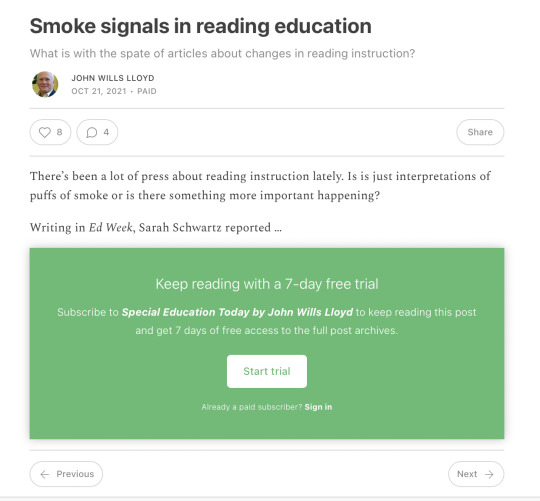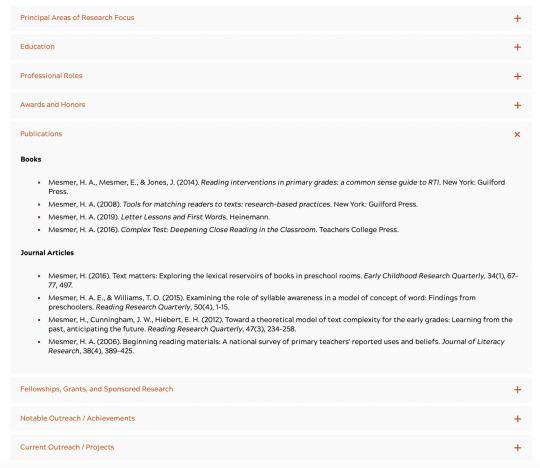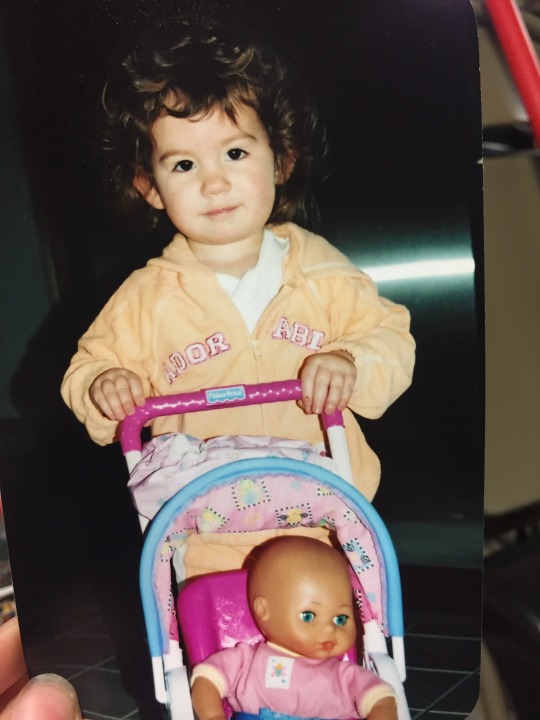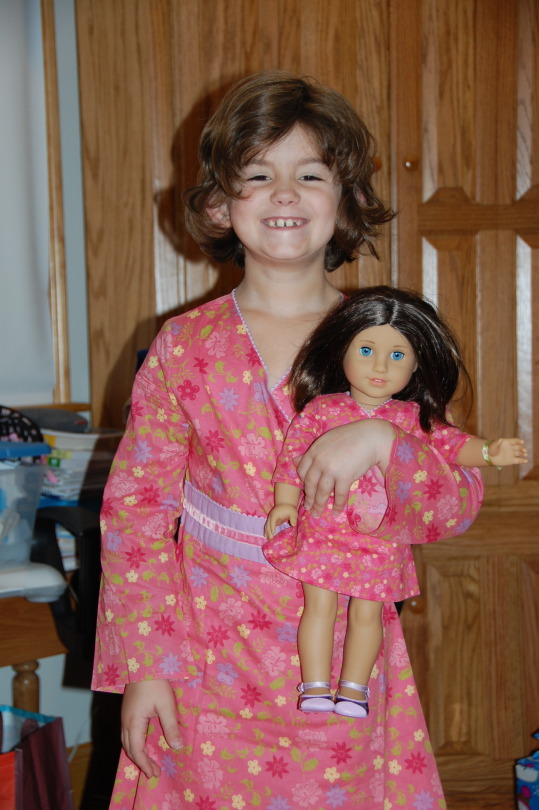Don't wanna be here? Send us removal request.
Text
12/4/2023
“Smoke Signals in Reading Education” (Willis Lloyd, 2021)
I wasn't able to read this article because you needed to subcribe and start a 7 day free trial.

“Hard Words; Why aren’t kids being taught to Read?” (Hanford, 2018)
Reading is not a natural process, and merely teaching phonics is not enough. There is a large body of research on the science of reading, but not a lot of schools implement the ideas presented in that research or don't even know about the research. This issue tends to stem at the University level with faculty who do not accurately inform their students on the science of reading and how to effectively teach reading once they are teachers in classrooms.
"Research shows that children who don't learn to read by the end of third grade are likely to remain poor readers for the rest of their lives, and they're likely to fall behind in other academic areas, too. People who struggle with reading are more likely to drop out of high school, to end up in the criminal justice system, and to live in poverty."
Reflection:
For this readerly exploration, I decided to share one of the readings with my mom to get her insight and perspective on it. When I am home we frequently have conversations related to our educational interests (reading & communciation & speech & special education), so I knew she would have a lot to share. She also has a lot of expertise in this area (as she shares down below) so I was very excited to hear her thoughts on this article! I sent her the “Hard Words; Why aren’t kids being taught to Read?” article. Down below is a list of all of her insights and messages she sent to me!!
This was an informative article that everyone needs to read!
I have been an educator for over 20 years and have taught through many pendulum swings in the education world. This is one that I hope doesn’t swing back to balanced literacy and result in more innocent students being failed by the decisions that other people make.
I am licensed as a special education teacher, special education administrator, an elementary teacher, and a reading specialist.
I have worked in various roles over my years. Here is the list from present down to the beginning. It is always my goal to educate students, families, and other educators because everyone is a part of the student’s equation and experience.
Language-based special education teacher grades 2-4 (current year)
Special education administrator inclusion special education (1 year)
Special education coach (for teachers) (1 year)
Reading Specialist/ instructional coach in K (5.5 years)
Literacy coach/instructional coach grades K-5 (2.5 years)
Grade 5 regular education teacher in an inclusion classroom (5 years)
Grade 5 special education teacher in an inclusion classroom (4 years)
Recommended resources:
The Right to Read film (eye-opening and heart-breaking) The Truth About Reading (also eye-opening and heart-breaking)
Sold a Story podcast Science of Reading the Podcast (Amplify)
Books: Reading Above the Fray~ Lindsey The Knowledge Gap ~ Wexler Language at the Speed of Light~ Seidenberg
We are in the midst of a literacy crisis and there isn’t an easy fix, but districts need to begin somewhere with small steps.
More students than ever are being found eligible for special education under SLD in reading- yet I wonder if it is actually a true disability or a result of poor instruction/untrained educators/clueless administrators that is causing the increase in identification.
Colleges and universities need to update their program requirements/courses to match the current research so that educators and SLPs come out prepared to teach the nitty-gritty skills related to phonics and reading.
Districts need to provide more training, partner with experts, and be willing to invest the time and money necessary to make the changes.
ALL students need instruction that is explicit, systematic, and multi-sensory with lots of repetition and practice, as well as quality reading materials that are based on the skills they have been taught.
All districts need to hyper focus on preschool to grade 2 by adding additional staff such as SLPs, dyslexia specialists, and reading specialists to support classroom teachers (especially veteran teachers who didn’t have the opportunity to be trained in these skills).
The time and money that districts have invested in a faulty system (balanced literacy) is sickening. This includes a district I worked in for 20 years…Lesley, LLI, and Reading Recovery were part of the curricula.
It breaks my heart that innocent students are victims of administrators and districts making decisions about curricula and training that they weren’t more careful about/researched and that not all K-2 teachers are equipped to teach students how to read.
The Fed Govt needs to provide money to districts to close the gaps with training, materials, and staff.
Parents need to arm themselves with research and information and push back on districts (reg ed and special ed students) about what is best for students to learn to read.
My dream job would be able to open a school focused on serving students with language-based learning disabilities and providing them with what they need to become strong readers, writers, and communicators.
My multimedia is a photo of my mom and I!

0 notes
Text
Fluency & Comprehension
11/27/2023
“Why Reading Fluency Should Be Hot!” (Rasinski, 2012)
“Fluency is a key component to proficient reading and [that] teacher-guided wide and deep reading are two ways to improve reading….moreover, authentic fluency instruction as described earlier in this article has shown remarkable potential for helping a wide range of students beyond the primary grades improve their fluency, overall reading achievement, and motivation for reading” (Rasinski, 2012)
Research has shown that deep reading, also known as “repeated reading” has shown to improve word accuracy, automaticity, comprehension, and attitude toward reading.
“She's My Best Reader; She Just Can't Comprehend’: Studying the Relationship Between Fluency and Comprehension” (Applegate, Applegate & Modla, 2011)
There is an interrelationship between fluency and comprehension, while researchers do not describe the relationship as specifically linear or causal, it is emphasized that the relationship between them should not be taken lightly and both should have attention given to them consistently in the classroom.
Fluency promotes comprehension and is necessary in order to develop strong comprehension when reading. Emphasis should not be placed on one or the other, but rather both in order for a student to become a strong reader.
Reflection:
For this reading exploration, I decided to identify a song that communicates the same or similar big ideas of the assigned reading. The song I chose was “Epiphany '' by Taylor Swift, but the reason why I chose this song is not because the lyrics communicate the same idea, but because its beat does. The beat in this song has a very smooth legato, which reminds me of the fluency readers should have as they read books. Legato indicates that musical notes are played or sung smoothly and connected. That is, the player makes a transition from note to note with no intervening silence. Just as fluency promotes comprehension, the strong and consistent legato in the song sustains my attention and my focus on the lyrics, allowing me to comprehend the story behind them. Similarly to when someone doesn't read fluently, it's harder to comprehend exactly what you are reading, when a song has more of a staccato than a legato, it is harder to listen to the story behind the lyrics because you're more focused on the beat.
youtube
0 notes
Text
Vocabulary Instruction
11/13/2023
“Vocabulary Practices in Prekindergarten and Kindergarten Classrooms” (Silverman & Crandell, 2011)
There are particular strategies that result in a stronger association and understanding of vocabulary words for younger students. The strategies include, acting out and illustrating words, analyzing words semantically applying words in new contexts, defining words explicitly in rich context, word study, and read aloud/ non-read-aloud times.
I found it interesting that the way that a book is read to a child influences their understanding of what certain vocabulary words mean.
“Word Study Instruction in the K-2 Classroom” (Williams, 2009)
"When integrated with a comprehensive literacy program, word study can help support young children's literacy development"
Word work is not the same thing as spelling instruction through memorization. Instead, it involves the teacher utilizing a variety of hands on activities for the students to explore and examine the relationship between words and letters.
Reflection:
For this readerly exploration I decided to identify a current event happening at the time the article was published to consider how the text might have been conceived or received. At the time that this article was written, the PBS tv show “Martha Speaks” was newly released. It was created because researchers learned that there is a huge gap between preschoolers of high and low socioeconomic status in terms of the amount of vocabulary words that they learn at home. The tv show was adapted from the book called “Martha” and was about a family dog who gains the power of speech after the letters in some alphabet soup wind up misrouted to her brain instead of her stomach. Researchers provided the input to the creators of the show about which words to introduce and teach to the young viewers of “Martha Speaks,” whose age range was 4-7 years old. The information discussed in this article definitely correlates to the goal of “Martha Speaks.” I think that the authors of these articles and the creators of “Martha Speaks” definitely would have agreed on the importance of vocabulary instruction for young children based on the goals they seemed to be aiming for through their writing and cartoon creation.

0 notes
Text
Phonics and How English Works
October 23, 2023
Introduction (Mesmer, 2019)
In order to make use of phonics, children first need to have a deep and clear understanding of how the system of writing works. There are two foundational concepts that children must understand before they can begin to grasp letter-sound relationships: the alphabet and the concept of words in print & writing letters (Mesmer, 2019, p. XV).
I have learned this in the field as my teacher does Fundations with our 2nd grade class, but it was cool reading that the modalities that Fundations utilizes for teaching phonics are proven to be useful ways to get children engaged during phonics lessons: writing on mini white boards, magnetic letters, scissors & paper for cutting out sounds, etc.
Chapter 1 (Mesmer, 2019)
The idea of teaching phonics seems complicated, but every sound and letter has a rule and the rules are learned, writing is a very easy task for students to accomplish, but it just takes time to get to that point.
I took phonetics this summer as a pre-requisite speech and language pathology course through Mass General Health Institute, so most of the information in this chapter was not new to me. One thing I found interesting is the link between phonetics and phonics. While I read this chapter I found myself learning a lot more of the rules of why letters are where they are in words when we spell them out, which is phonics. On the other hand, while I learned all about blends, r-controlled vowels, consonant clusters, and diphthongs this summer, my instruction was more focused on HOW we make each sound with our tongue and oral cavity, the sounds that each one makes and on learning the IPA phoneme symbol for each one, and being able to transcribe English words into phonemes based on my knowledge of which vowels are used in stressed syllables or unstressed syllables, etc. Due to this knowledge, I feel like it will definitely be hard to grasp the idea of teaching phonics while I am doing field experience because I think about all of those concepts in a different way than how they are being taught in phonics instruction in the classroom.
Reflection:
For this readerly exploration I decided to learn something about the author of Letter Lessons and First Words and note how what I learned impacts my motivation for reading. The author of the book is Heidi Anna Mesmer, she is a tenured head professor of literacy at Virginia Tech and has studied beginning reading materials, text difficulty, and struggling readers since 1999. In addition to this book, she has written 3 other books and 4 journal articles on early reading. I was able to find her LinkedIn fairly easily after searching her name, and found out she has been working at Virginia tech as a professor in the literacy department for 21 years; 16 years as an assistant professor and 5 years so far as the head professor. This is the first time that I can recall researching the writer of a book or article I am reading before reading it, and I’m so glad I did! Had I not researched her I would not have felt inclined to read her book, but now knowing her level of expertise I am excited to read all of the knowledge she has to share with elementary school teachers in regard to phonics and early reading.
Multimedia:
I included a photo of her and all of her publications!


2 notes
·
View notes
Text
Interactive Read Alouds
10/9/2023
Fisher chapter 2
It is important to keep whole-group instruction at grade level and explicitly taught. These both ensure that students grow into the type of knowledge and thinking that is expected of students their age. By instruction being explicit they are able to develop the knowledge and have a full understanding of terminology and how each strategy is used. In addition to that, students should be given opportunities during whole group instruction to practice the skills you expect of them.
I had taken the time to think about the amount of power that read alouds hold. Not only are they a classroom practice that students love and look forward to, but they also are powerful ways to develop listening and thinking skills, as well as build on their background knowledge so they can better understand texts they read independently (Fisher, 2020, p. 19). However, all of that is only achieved through interactive read alouds, rather than traditional read alouds where there is no discussion or questions being asked about the text for students to think through.
“Talking Back & Talking Over: Young Children’s Expressive Engagement During Read-Aloud Storybooks” Sipe (2002)
Engagement with the text during read alouds is extremely important for students to get a strong grasp of the story being read to them, to develop literacy skills like stronger comprehension. However, every child responds differently to text and it's important that we understand each of the ways so that we can support our students and their cognitive development through read alouds.
I loved learning about the different ways that as a teacher you can get students to participate in expressive engagement during read alouds, because as I have noticed in field experience, not every student is naturally inclined to participate in expressive engagement. Some of the strategies include, dramatic reenactment of a part of a story (dramatization), valuing and accepting responses when children do respond during a read aloud (talking back), and asking open-ended questions during a read aloud like “what would you say?” or “What would you do if you were [character’s name]?” (Sipe , 2002, p. 481).
Reflection:
For this readerly exploration, I decided to skim the course readings for unfamiliar words and then take the time to look up the definitions of those words. I appreciated how this exploration almost placed me in the student's shoes and had me practicing a technique that new readers often use to expand their vocabulary. Through this exploration I was able to reflect on the fact that since I am an aged reader, I have the knowledge background and ability to use context clues to understand most vocabulary words that I don't know in a section of reading, which is why at 20 years old I less frequently research words I don't know while reading text. This is a list of the words that I researched the definition of, followed by their definition.
Nascent: Just coming into existence and beginning to display signs of future potential.
Cadence: A modulation or inflection of the voice
Misdirective clues: Direct a reader to an incorrect meaning of a word. For example, “The climb up the mountain took longer than John and Patrick expected. The cliffs were steeper than Patrick remembered, and they had to walk an extra mile as the path was blocked at one point.”
Nondirective clues: Provides limited help in deciphering the meaning of the word. For example, “Freddie looked over the members of the team she'd been assigned. Each looked more hapless than the next.” Readers know hapless (adjective), is something a person can be, but the context does not provide clues to the word's meaning.
Multi-Media:

This image explains the difference between mis-directive and non-directive clues in a clear manner using a venn diagram!
1 note
·
View note
Text
Balanced Literacy & Independent Reading
9/25/2023
Fisher Chapter 1
In balanced literacy classrooms, students are taught how to write and then write everyday. By focusing on reading, writing will naturally improve, and by focusing on writing, reading will naturally improve. They are not independent of one another.
I found it interesting that in 2000, it was reported that first graders only average about 3.6 minutes per day reading informational, nonfiction text. Elementary schools focus much more on fiction text, when they should be focused on informational text as well. This is because once a child gets to high school & college a majority of the text they will be reading is informational.
Fisher Chapter 7
Just like anything else in life, without practicing reading on their own, the instruction that teachers provide will not stick. That is why independent reading is so important, it allows students to practice the skills that they are being taught in a way that is engaging for each of them on an individual level.
I had never really thought about independent reading as anything more than a way to let students enjoy reading and become more motivated to read. However, you can do so much in the classroom through independent reading. For example, inquiry projects, gathering data on fluency by listening to them read out loud in pairs, book clubs, and so much more!
Reflection:
For this exploration I'm documenting my initial response to what I read, considering how the ideas I read made me feel and what they made me think about. The book I bought was used, so it has lots of annotations and highlights, I also noticed myself focusing on those and paying more attention to those details than details that were not highlighted in the text. Personally, I found that chapter 7 was much more engaging for me to read than chapter 1. I think that is because there were more images of a classroom that captured my attention, versus just graphs and diagrams like Chapter 1. I also found having a section for what independent reading should look like in various grade levels to be super helpful. I agree that it is crucial that children are able to choose the books that they read independently because forcing a child to read a specific book during independent reading will not foster their love for literacy at an early age, rather it will stifle it. Chapter 7 had me reflecting on books that I loved to read independently as a kid. One of my all-time favorites was the Magic Tree House series in 2nd and 3rd grade. I absolutely loved how every book was so unique and they each taught you about a historical event or person.
Multimedia:
youtube
3 notes
·
View notes
Text
Enhancing Language Development and Literacy Through Play
9/18/2023
"Enriching and Assessing Young Children’s Multimodal Storytelling”
Literacy lessons should involve engaging, active, and creative tasks, not merely reading a book to your students and discussing the writing within it.
Growing up I took part in writer's workshops, so reading about the recent introduction and transition to literacy playshops at the end of the year was really intriguing. First, the class learns elements of stories and how to write, and then they transition to implementing those skills into storytelling in various ways.
"Why Children Need Play"
Play is a crucial part of a child's development, and it is certainly not something that should be overlooked when it comes to teaching in early childhood classrooms.
Today there are more adult-directed activities than in the past, and children spend more time playing with electronics than they do taking part in pretend play, which is not as conducive to building imagination.
"Building Language and Literacy Through Play"
There are various ways to implement play into early childhood education classrooms that result in mature, high-quality play that builds language and enhances literacy skills
Dramatic play provides the best opportunities for children to practice language and literacy because it encompasses so much that would totally enhance growth in those areas. When children participate in dramatic play they should always have access to a variety of props, multiple roles & themes, and a scenario that incorporates solving a problem or conflict resolution.
Reflection:
For this readerly exploration, I decided to provide an interpretation of the assigned reading through the lens of a course I am taking this semester- Infants, Toddlers, and Families. The course examines the role of the family and other caregivers in the development of infants and toddlers (ages 0-3), and is focused on Early Intervention. We are learning about all five areas of development, milestones for various ages in each one, and ways early intervention specialists can help grow a child’s development in each area. A huge emphasis is placed on play in Early Intervention. In Early Intervention it is crucial to consider the goals when picking toys as treatment materials. Play is an integration of multiple developmental areas, and offers unlimited learning opportunities when strategically selected. When a child plays, not only do they grow in the area of social-emotional development and communication development, but also in their physical development (fine motor skills) and cognitive development. In addition to that, these readings also demonstrated the role that play can have in the classroom in terms of literacy development. If we want young children to be engaged and enthralled by literature, we must incorporate play activities that are engaging for them within literacy lessons and develop their love for it that way.
Multimedia:

Here is an example of dramatic play as a child! Here I was playing the role of a mother.

As I got older I made the transition from playing dramatic play with myself as a primary role, to playing American Girl Dolls with my friends where we role-played and our dolls played house!
3 notes
·
View notes